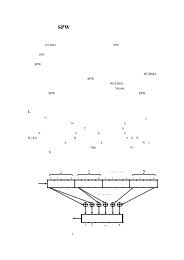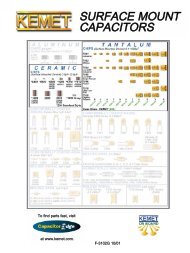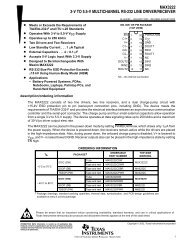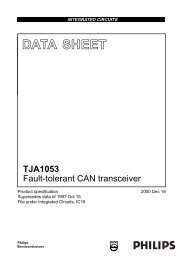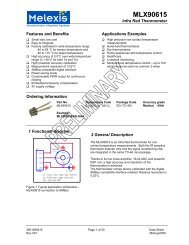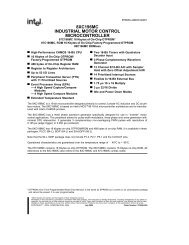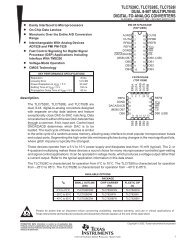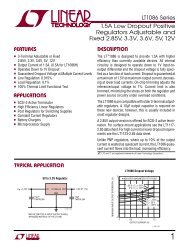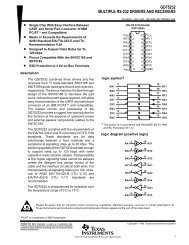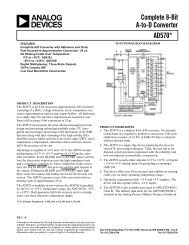High-Voltage, High-Current OPERATIONAL AMPLIFIER OPA544
High-Voltage, High-Current OPERATIONAL AMPLIFIER OPA544
High-Voltage, High-Current OPERATIONAL AMPLIFIER OPA544
Create successful ePaper yourself
Turn your PDF publications into a flip-book with our unique Google optimized e-Paper software.
POWER DISSIPATIONPower dissipation depends on power supply, signal and loadconditions. For dc signals, power dissipation is equal to theproduct of output current times the voltage across the conductingoutput transistor. Power dissipation can be minimizedby using the lowest possible power supply voltagenecessary to assure the required output voltage swing.For resistive loads, the maximum power dissipation occursat a dc output voltage of one-half the power supply voltage.Dissipation with ac signals is lower. Application BulletinAB-039 explains how to calculate or measure power dissipationwith unusual signals and loads.HEATSINKINGMost applications require a heat sink to assure that themaximum junction temperature is not exceeded. The heatsink required depends on the power dissipated and onambient conditions. Consult Application Bulletin AB-038for information on determining heat sink requirements.The mounting tab of the surface-mount package versionshould be soldered to a circuit board copper area for goodheat dissipation. Figure 3 shows typical thermal resistancefrom junction to ambient as a function of the copper area.THERMAL PROTECTIONThe <strong>OPA544</strong> has thermal shutdown that protects the amplifierfrom damage. Any tendency to activate the thermalshutdown circuit during normal operation is indication ofexcessive power dissipation or an inadequate heat sink.The thermal protection activates at a junction temperature ofapproximately 155˚C. For reliable operation, junction temperatureshould be limited to 150˚C, maximum. To estimatethe margin of safety in a complete design (including heatsink), increase the ambient temperature until the thermalprotection is activated. Use worst-case load and signal conditions.For good reliability, the thermal protection shouldtrigger more than 25˚C above the maximum expected ambientcondition of your application. This produces a junctiontemperature of 125˚C at the maximum expected ambientcondition.Depending on load and signal conditions, the thermal protectioncircuit may produce a duty-cycle modulated outputsignal. This limits the dissipation in the amplifier, but therapidly varying output waveform may be damaging to someloads. The thermal protection may behave differently dependingon whether internal dissipation is produced bysourcing or sinking output current.OUTPUT STAGE COMPENSATIONThe complex load impedances common in power op ampapplications can cause output stage instability. Figure 3shows an output series R/C compensation network (1Ω inseries with 0.01µF) which generally provides excellent stability.Some variation in circuit values may be required withcertain loads.UNBALANCED POWER SUPPLIESSome applications do not require equal positive and negativeoutput voltage swing. The power supply voltages of the<strong>OPA544</strong> do not need to be equal. For example, a –6Vnegative power supply voltage assures that the inputs of the<strong>OPA544</strong> are operated within their linear common-moderange, and that the output can swing to 0V. The V+ powersupply could range from 15V to 65V. The total voltage (V–to V+) can range from 20V to 70V. With a 65V positivesupply voltage, the device may not be protected from damageduring short-circuits because of the larger V CE duringthis condition.OUTPUT PROTECTIONReactive and EMF-generating loads can return load currentto the amplifier, causing the output voltage to exceed thepower supply voltage. This damaging condition can beavoided with clamp diodes from the output terminal to thepower supplies as shown in Figure 4. Fast-recovery rectifierdiodes with a 4A or greater continuous rating are recommended.50THERMAL RESISTANCE vsCIRCUIT BOARD COPPER AREACircuit Board Copper AreaThermal Resistance, θ JA (°C/W)40302010<strong>OPA544</strong>FSurface Mount Package1oz copper00 1 2 3 4 5Copper Area (inches 2 )<strong>OPA544</strong>Surface Mount PackageFIGURE 3. Thermal Resistance vs Circuit Board Copper Area.7 <strong>OPA544</strong>®



